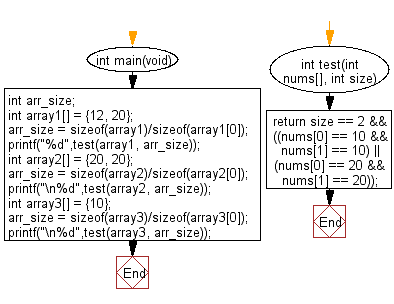C Exercises: Check a given array of integers and return true if the array contains 10 or 20 twice
C-programming basic algorithm: Exercise-43 with Solution
Write a C program to check a given array of integers and return true if the array contains 10 or 20 twice. The length of the array will be 0, 1, or 2.
C Code:
#include <stdio.h>
#include <stdlib.h>
int main(void){
int arr_size;
int array1[] = {12, 20};
arr_size = sizeof(array1)/sizeof(array1[0]);
printf("%d",test(array1, arr_size));
int array2[] = {20, 20};
arr_size = sizeof(array2)/sizeof(array2[0]);
printf("\n%d",test(array2, arr_size));
int array3[] = {10};
arr_size = sizeof(array3)/sizeof(array3[0]);
printf("\n%d",test(array3, arr_size));
}
int test(int nums[], int size)
{
return size == 2
&& ((nums[0] == 10 && nums[1] == 10)
|| (nums[0] == 20 && nums[1] == 20));
}
Sample Output:
0 1 0
Pictorial Presentation:
Flowchart:

C Programming Code Editor:
Contribute your code and comments through Disqus.
Previous: Write a C program to check if a given array of integers and length 2, does not contain 15 or 20.
Next: Write a C program to check a given array of integers, length 3 and create a new array. If there is a 5 in the given array immediately followed by a 7 then set 7 to 1.
What is the difficulty level of this exercise?
Test your Programming skills with w3resource's quiz.
C Programming: Tips of the Day
Static variable inside of a function in C
The scope of variable is where the variable name can be seen. Here, x is visible only inside function foo().
The lifetime of a variable is the period over which it exists. If x were defined without the keyword static, the lifetime would be from the entry into foo() to the return from foo(); so it would be re-initialized to 5 on every call.
The keyword static acts to extend the lifetime of a variable to the lifetime of the programme; e.g. initialization occurs once and once only and then the variable retains its value - whatever it has come to be - over all future calls to foo().
Ref : https://bit.ly/3fOq7XP
- New Content published on w3resource:
- HTML-CSS Practical: Exercises, Practice, Solution
- Java Regular Expression: Exercises, Practice, Solution
- Scala Programming Exercises, Practice, Solution
- Python Itertools exercises
- Python Numpy exercises
- Python GeoPy Package exercises
- Python Pandas exercises
- Python nltk exercises
- Python BeautifulSoup exercises
- Form Template
- Composer - PHP Package Manager
- PHPUnit - PHP Testing
- Laravel - PHP Framework
- Angular - JavaScript Framework
- Vue - JavaScript Framework
- Jest - JavaScript Testing Framework
